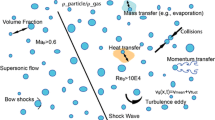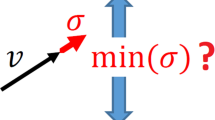Abstract
The acceleration of aluminum particles with a 5μm diameter in the flow field behind an incident shock wave was investigated experimentally in a 10-m long and 70 mm inner diameter shock tube. By means of instantaneous Laser Doppler Velocimetry (LDV) the velocity of the particles was observed directly. The light scattered by the moving particles is Doppler shifted and sent to the laser Doppler velocimeter. The velocimeter essentially consists of a phase-stabilized Michelson interferometer used as a sensitive spectrometer. An electro-optical circuit ensures the phase stabilization that results in a voltage signal independent of the scattered light intensity and proportional to the mean velocity of the particles at the measurement point. Because of the very short response time (1μs) of the LDV system used here, the latter gives a continuous real-time signal of the particle acceleration. To avoid particle oxidation the particles were accelerated by a high-speed nitrogen gas flow. From the measured velocity the dimensionless drag coefficient was calculated. The drag coefficient is related to the fluid dynamic force exerted by the gas on the particles. The experimental data were compared to theoretical models from the literature. A significant deviation between the model and the experimental data was observed. This deviation is supposed to be induced by the shock wave, which hits the particles and breaks them into pieces of a smaller diameter. Further experiments will be carried out in the future to check the size distribution of the particles after the shock has gone past them.
Similar content being viewed by others
References
Basset A.B.: Treatise on Hydrodynamics. Bell, London (1888)
Boussinesq M.J.: Sur la résistance qu’oppose un liquide indéfini en repos .... C. R. Acad. Sci. Paris 100, 935–937 (1885)
Carlson D.J., Hoglund R.F.: Particle drag and heat transfer in rocket nozzles. AIAA J. 2(11), 1980–1984 (1964)
Crowe , C.T. (eds): Multiphase Flow Handbook. CRC Press, New York (2006)
Crowe C.T., Babcock W.R., Willoughby P.G.: Drag coefficient for particles in rarefied low Mach number flows. Prog. Heat Mass Transf. 6, 419–428 (1973)
Crowe C.T., Sommerfeld M., Tsuji Y.: Multiphase Flows with Droplets and Particles. CRC Press, New York (1998)
Henderson C.B.: Drag coefficients of spheres in continuum and rarefield flows. AIAA J. 14(6), 707–708 (1976)
Hermsen, R.W.: Review of particle drag models. In: JANAF Performance Standardization Subcommittee 12th Meeting Minutes, p. 113, CPIA (1979)
Igra, O., Takayama, K.: Shock-tube study of the drag coefficient of a sphere in a nonstationary flow. Proc. R. Soc. Lond. Ser. A Math. Phys. Eng. Sci. 442(1915), 231–247 (1993)
Jourdan G., Houas L., Igra O., Estivalezes J.L., Devals C., Meshkov E.E.: Drag coefficient of a sphere in a non-stationary flow: new results. Proc. R. Soc. London Ser. A Math. Phys. Eng. Sci. 463(2088), 3323–3345 (2007)
Kim S., Karrila S.J.: Microhydrodynamics: Principles and Selected Applications. Butterworth, Heinemann, Boston (1991)
Luo X., Wang G., Olivier H.: Parametric investigation of particle acceleration in high enthalpy conical nozzle flows for coating applications. Shock Waves 17, 351–362 (2008)
Millikan R.A.: The general law of fall of a small spherical body through a gas and its bearing upon the nature of molecular reflection from surfaces. Phys. Rev. 22, 1–23 (1923)
Oseen C.W.: Über die Stoke’s Formel, und über eine verwendte Aufgabe in der Hydrodynamik. Ark. Math. Astronom. Fys. 6(29), 1–20 (1927)
Saito T., Saba M., Sun M., Takayama K.: The effect of an unsteady drag force on the structure of a non-equilibrium region behind a shock wave in a gas-particle mixture. Shock Waves 17, 255–262 (2007)
Smeets G., George A.: Instantaneous laser Doppler velocimeter using a fast wavelength tracking Michelson interferometer. Rev. Sci. Instrum. 49(11), 1589–1596 (1978)
Smeets, G., Mathieu, G.: Optische Dopplermessung mit dem Michelson-Spektrometer. ISL Report R 123/83 (1983)
Sommerfeld M.: The unsteadiness of shock-waves propagating through gas-particle mixtures. Exp. Fluids 3(4), 197–206 (1985)
Stokes G.G.: On the effect of internal friction of fluids on the motion of pendulums. Trans. Camb. Philos. Soc. 9, 8–106 (1851)
Tanguay V., Higgins A.J., Zhang F.: A simple analytical model for reactive particle ignition in explosives. Propellants Explos. Pyrotech. 32(5), 371–384 (2007)
White F.M.: Viscous Fluid Flow. McGraw Hill, New York (1974)
Yarin L.P., Hetsroni G.: Combustion of Two-Phase Reactive Media. Springer, Berlin (2004)
Author information
Authors and Affiliations
Corresponding author
Additional information
Communicated by O. Igra.
Rights and permissions
About this article
Cite this article
Schlöffel, G., Bastide, M., Bachmann, S. et al. Investigation of the acceleration of aluminum particles behind a shock wave using instantaneous Laser Doppler Velocimetry. Shock Waves 19, 125–134 (2009). https://doi.org/10.1007/s00193-009-0188-8
Received:
Accepted:
Published:
Issue Date:
DOI: https://doi.org/10.1007/s00193-009-0188-8




